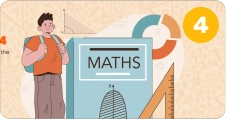The axis of symmetry is a line that splits a shape into two equal parts. When you look at the shape from this line, the two parts look like mirror images. You can also fold the shape along this line; the two parts will match. The axis of symmetry is essential in math. It helps us understand different shapes, equations, and graphs better. We will learn more about the axis of symmetry and how to use it in different situations.
What is Symmetry
Some things look the same on both sides. This is called symmetry. You can see symmetry in nature, art, and buildings. For example, a flower or a butterfly has symmetry. You can draw a line in the middle of them, and the two sides will look the same. Symmetry makes things look nice and balanced. For example, many paintings and buildings have symmetry. People have been studying symmetry for a long time. Symmetry is helpful in many fields, such as engineering, physics, and chemistry.
There are many different types of symmetry, including:
Reflectional symmetry
This is an easy way to explain symmetry. It means that something can be cut in half, and the two parts look identical. For example, a square has symmetry because you can fold it in half along any side, and the two parts will match. Symmetry makes things look nice and balanced.
Rotational symmetry
This is another way to explain symmetry. It means something can be turned around a point and still look the same. For example, a circle has symmetry because you can turn it around its center by any amount, and it will not change. Symmetry makes things look nice and balanced.
Translational symmetry
This is another explaining symmetry. It means something can be slid along a line and still look the same. For example, a line has symmetry because you can slide it along, and it will not change. Symmetry makes things look nice and balanced.
Types of Axes of Symmetry
The axis of symmetry is a line that makes a shape look the same on both sides. The two sides will match if you fold the shape along this line. The axis of symmetry can help us learn more about shapes and how they are made. There are different kinds of axes of symmetry, and we will look at some of them:
Vertical Axis of Symmetry:
This is a line that goes up and down through the middle of a shape. It splits the shape into two parts that look like mirror images of each other. For example, the letter “A” has a vertical axis of symmetry.
Horizontal Axis of Symmetry:
This line goes left and right through the middle of a shape. It splits the shape into two parts that look like mirror images of each other. For example, the letter “H” has a horizontal axis of symmetry.
Diagonal Axis of Symmetry:
This is a line that goes at an angle through the middle of a shape. It splits the shape into two parts that look like mirror images of each other. For example, a triangle has three diagonal axes of symmetry, one for each side.
How to find the axis of symmetry for a parabola
Axis of Symmetry for a Parabola:
The axis of symmetry for a parabola is a vertical line that divides the parabolic curve into two symmetrical halves. It passes through the vertex of the parabola and is always a vertical line due to the nature of quadratic functions.
Formula: The formula to find the axis of symmetry for a parabola is:
x = -b / (2a)
Here, “a” represents the coefficient of the x^2 term in the quadratic equation, and “b” represents the coefficient of the x term.
Example:
Let’s consider the quadratic equation y = 2x^2 + 4x – 3. To find the axis of symmetry, we can use the formula:
x = -b / (2a)
In this equation, a = 2 and b = 4. Plugging in these values, we have:
x = -(4) / (2 * 2) = -4 / 4 = -1
Hence, the axis of symmetry for the given parabola is x = -1. This means that the line x = -1 divides the parabolic graph into two symmetrical halves.
How to find the axis of symmetry For a quadratic function
Axis of Symmetry for a Quadratic Function:
The axis of symmetry for a quadratic function is the same as the axis of symmetry for a parabola. A vertical line divides the quadratic graph into two symmetrical parts.
Formula: The formula to find the axis of symmetry for a quadratic function is the same as for a parabola: x = -b / (2a)
Here, “a” represents the coefficient of the x^2 term in the quadratic function, and “b” represents the coefficient of the x term.
Example:
Consider the quadratic function f(x) = -3x^2 + 6x + 2. To determine the axis of symmetry, we can use the formula:
x = -b / (2a)
In this function, a = -3 and b = 6. Plugging these values into the formula, we get:
x = -(6) / (2 * -3) = -6 / -6 = 1
Therefore, the axis of symmetry for the given quadratic function is x = 1. This implies that the line x = 1 divides the quadratic graph into two symmetrical halves.
The axis of symmetry for both a parabola and a quadratic function is a vertical line that divides the graph into two symmetric parts. The formula x = -b / (2a) is used to calculate the x-coordinate of the axis of symmetry, where “a” and “b” are the coefficients of the quadratic equation or function.
Examples of axes of symmetry in geometry:
An axis of symmetry is a line that cuts a shape into two parts that are the same. Some shapes have more than one axis of symmetry, like squares, circles, and triangles with equal sides. Knowing about axes of symmetry helps us study how shapes are balanced.
Here are some example axes of symmetry in geometry
Square:
A square has four axes of symmetry. They are lines that connect the midpoints of opposite sides, forming two pairs of parallel lines that intersect at right angles.
Rectangle:
A rectangle has two axes of symmetry. They are lines that connect the midpoints of opposite sides and are parallel to the shorter sides of the rectangle.
Circle:
A circle has an infinite number of axes of symmetry. Any line passing through the circle’s center can act as an axis of symmetry. Additionally, any diameter of the circle serves as an axis of symmetry.
Triangle:
- Equilateral Triangle: An equilateral triangle has three axes of symmetry. They are lines that connect each vertex with the midpoint of the opposite side.
- Isosceles Triangle: An isosceles triangle has one axis of symmetry. The line divides the triangle into two congruent halves by bisecting the base.
- Scalene Triangle: A scalene triangle has no axes of symmetry since its sides and angles are all different.
Real-World Examples of the Axis of Symmetry
- Architectural wonders like the Taj Mahal and the Parthenon are perfect examples of symmetry. They are grand and stable.
- Nature’s floral masterpieces like sunflowers and orchids have radial symmetry, which means they have harmonious patterns that captivate us.
- Animals like butterflies and peacocks have bilateral symmetry, which means their mirrored features reflect exquisite designs.
- Crystals and minerals like quartz and diamonds have intricate symmetrical patterns that mesmerize us with their geometric precision.
In all these realms, the axis of symmetry reveals the inherent balance and beauty that permeate our world, captivating and inspiring us in countless ways.
Summary
This article provides a concise and informative explanation of the axis of symmetry in mathematics. It covers symmetry concepts, different types of symmetry, and their significance in various fields. The article also includes examples of finding the axis of symmetry for parabolas, quadratic functions, and geometric shapes.
Moonpreneur understands the needs and demands this rapidly changing technological world is bringing with it for our kids. Our expert-designed Advanced Math course for grades 3rd, 4th, 5th, and 6th will help your child develop math skills with hands-on lessons, excite them to learn, and help them build real-life applications.
Register for a free 60-minute Advanced Math Workshop today!
















